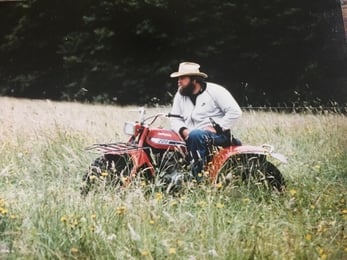Take the Risk
My dad was a man of many hats — from the top hat, he wore briefly as a university student in 1937, to the cowboy hat he wore each day at the cattle ranch that he and his brother owned in the 1940’s and 50’s, to the baseball cap he donned when he returned home late afternoons to coach the Little League baseball team I played on in 1954-57.
But it was his soiled, well-worn cowboy hat that he gave me in 1959 that I remember best.
I am wearing that hat in this photo taken by my wife in 1985. It represents a magical time in the surprising journey my wife and I embarked on in 1980, fifteen years post-SCI. At the time, I was teaching writing classes at Portland Community College, about as far from farming and owning cattle as you can get. When an opportunity came, we gambled and purchased land that dictated our future. It simply demanded to be populated by cattle, and that meant we had to find a way to do it.
We started by letting our new country neighbor keep her bred heifers on our pasture for a calving season. There were only seven, and my job was to keep watch over them, provide them with salt blocks, keep them from straying, and let my neighbor know when one went into labor. That’s what I’m doing in this photo — straining to get a good look at a heifer as it lay in the tall grass. If you look closely, you’ll see what resembles a cigarette dangling from my lips, but it’s not. It's a sprig of Timothy grass with a full head.

Not long after that spring, we bought an old Ford Supercab pickup and began scouring the Willamette Valley for heifers and bred cows to purchase and bring to our farm. It took years to build our own small herd and learn the ropes of feeding, breeding, vaccinating and castrating calves, managing pastureland, fencing and moving the growing herd from field to field to keep up with the fresh grass, and selling the calves when they were weaned. Along the way, we purchased a few bulls, leased more land that adjoined ours, traveled to auctions and other farms and ranches to buy or sell cattle, and made a small profit with a herd of about 20 and a bull. But what it was really all about had little to do with money. It was about growth. Personal growth, getting out of our comfort zones, moving beyond our fears, and taking risks.
Most of all, it was about leaving behind the stereotypes that limited us to what others assumed would define our reality. How could a paralyzed wheelchair user and his 5-foot-three, 110-pound wife manage and run a farm (one step at a time), operate two modest tractors (hand controls), grow organic vegetable crops (with help from laborers), start a delivery business (take the produce directly to restaurants and markets), grow and sell hay (add fertilizer and water and advertise), and make it all work (persevere).
When I look back, those days were the most precious times in our lives. Everywhere we looked, life abounded. The farm was alive with not only livestock, but also deer, coyotes, blue herons, geese and ducks, pigeons and all manner of birds and mammals. Rabbits, dogs, and cats wandered onto our property and found their home here. Our old 1880s barn was always home to a barn owl, and it still is to this day.
It didn’t take long for us to realize that only one thing was missing — children. And so, after years of trying and failing to get pregnant, we adopted a one-day-old infant. How fortunate we were! Now our daughter has given us four grandsons, and our hearts are full.
Tim Gilmer graduated from UCLA in the late-1960’s, added an M.A. from the Southern Oregon University in 1977, taught writing classes in Portland for 12 years, then embarked on a writing career. After becoming an Oregon Literary Fellow, he went on to join New Mobility magazine in 2000 and edited the magazine for 18 years. He has published upwards of 100 articles, 200 columns, occasional movie reviews and essays. He and Sam, his wife and companion of 47 years, also own and operate an organic farm south of Portland, where they live with their daughter and son-in-law, four grandsons, and a resident barn owl. An excerpt from a memoir about his early post-SCI years, as part of a compendium of his writing over the past 30 years, can be read at his website — All You Need —
Join Our Movement
What started as an idea has become a national movement. With your support, we can influence policy and inspire lasting change.
Become an Advocate